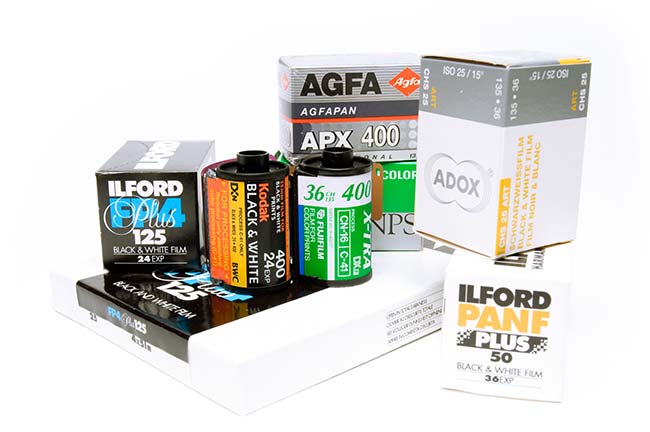Film
Since the mid-nineteenth century, there have been a fair amount of processes or methods of producing photographic imagery. It was not until late in that century that what we know of as film came about.
Handling
Film (obviously?) is light-sensitive. Modern films require very little light to be exposed. When handling film, a bit of care is indicated. Before the film is loaded in the camera (or film holder), leave it in its original packaging. This will protect it from moisture and dirt, as well as light.
Do not freeze film. If you are storing it for some time, refrigerate it, but do not freeze it. Be sure and let it warm up for a bit before using, as there can be condensation on it. Keep film from excessive heat. In particular, this means do not leave film in automobiles, even in fairly moderate temperatures, as automobiles tend to heat up rather nicely.
Structure

Film is basically composed of a flexible plastic substrate, or base, with a gelatin emulsion coated on one side. There are some additional layers to the emulsion layer. From the top, there is an anti-scratch layer. This helps protect the emulsion, and is washed away during processing.
Next is the emulsion layer or layers. Black and white film may have a single layer of emulsion, while color will have at least three. The emulsion is gelatin combined with silver halides (metallic salts of silver), bromides, iodides and/or chlorides. It may also contain dyes, to help the sensitivity to different colors. With that, black and white, panchromatic film is much more sensitive to the blue end of the color spectrum than the red.
Silver halides (salts of silver) are metallic silver compounded with iodine, chlorine, or bromine. Light hitting these salts reduces it to its components, releasing the silver, which is black, and forms an image. Modern film uses small amounts of halides, which require relatively small amounts of light to be activated. This forms what is called a latent image, which is not visible. The development process amplifies this latent image into one that is visible. (The same thing happens with photographic paper, and you can actually watch the latent image become visible). On film, the image formed is reversed from the scene, or a negative. Special processing of some can reverse this out again, and form a positive image on the film.
Next is a layer of adhesive, to help the emulsion stick to the base.
Then comes the film base. This base, or substrate, was originally nitrate-based, or nitro-cellulose. This carried a couple of distinct disadvantages: it was highly flammable, and it deteriorated rather rapidly. Nitrate film was replaced by acetate film starting around 1910. Kodak introduced it, calling it 'safety film'. Contemporary films nearly all use a polyester base, preferred because of its durability, strength, stability, and flexibility.
Then we have another layer of adhesive, which helps the final layer, the antihalation backing, adhere to the base. The antihalation layer absorbs light that makes it all the way through the film, preventing it from bouncing back up and causing rings, or halos, to form. This layer, like the anti-scratch layer, is also washed away during processing.
Packaging

Film is packaged in metal or plastic cassettes, paper-backed on rolls, in sheets, and in what are called bulk rolls, which you load into cassettes yourself. 135, or 35mm film comes on cassettes, usually of 24 or 36 exposures, and in bulk rolls (usually 100 feet). The cassettes are commonly DX coded, which means that cameras that have the ability to read the coding will automatically set the film speed. Medium format, 120 or 220, comes paper-backed on spools or rolls. 120 is a shorter roll than 220, but it depends on the format of the camera on how many frames you get (12-16). Sheet film comes in boxes, in 4 × 5, 8 × 10, and 11 × 14 inches. There are fewer choices for the larger sizes.
Despite the rise of digital photography, there remains quite a variety of films available on the market. They are not as available, as many small outlets have stopped carrying film, as the consumer market waned, but the dedicated amateur and professional has been pretty used to ordering supplies for some time. The availability of color materials has been reduced quite a bit, as the main market for these, that of commercial photography, has moved to digital workflows.